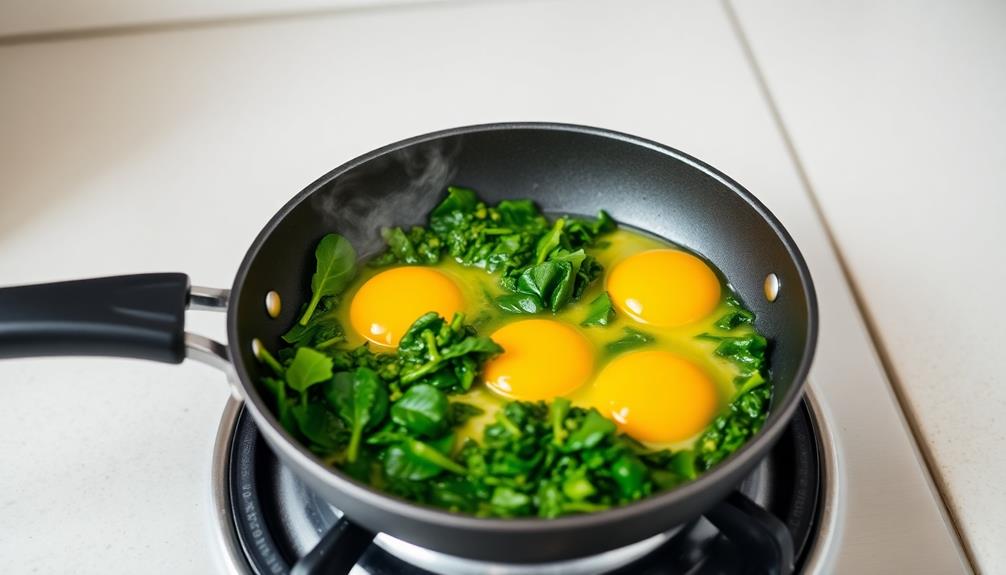Kick-start your day with delightful low-FODMAP breakfast ideas that nourish your gut! Start with creamy oatmeal made with almond milk, or blend up a smoothie packed with spinach, banana, and lactose-free yogurt. Scrambled eggs pair perfectly with low-FODMAP veggies like spinach. For a heartier option, try quinoa breakfast bowls topped with berries and nuts. No matter your preference, you'll find a range of tasty and FODMAP-friendly choices to fuel your morning. And if you keep reading, you'll uncover even more details to help you embrace the low-FODMAP lifestyle.
Key Takeaways
- Understand the origins and purpose of the low-FODMAP diet in managing digestive symptoms, particularly for individuals with IBS.
- Emphasize the importance of meal planning, ingredient stocking, and batch cooking to ensure successful low-FODMAP breakfast preparation.
- Explore a variety of nourishing low-FODMAP breakfast options, including oatmeal, smoothies, scrambled eggs, quinoa bowls, and chia seed pudding.
- Incorporate mindful eating practices, such as awareness, diet adjustment, and stress reduction, to enhance the low-FODMAP breakfast experience.
- Embrace the low-FODMAP lifestyle by understanding its benefits, experimenting with diverse food options, and engaging with community resources for support and recipe ideas.
History
The origins of the low-FODMAP diet can be traced back to the 1990s, when researchers at Monash University in Australia began investigating the effects of certain carbohydrates on digestive health.
They discovered that certain short-chain carbohydrates, collectively known as FODMAPs (Fermentable Oligosaccharides, Disaccharides, Monosaccharides, and Polyols), can trigger uncomfortable symptoms in people with irritable bowel syndrome (IBS) and other digestive issues.
Over the next two decades, the low-FODMAP diet was developed and refined, providing a structured approach to managing digestive symptoms by limiting high-FODMAP foods and emphasizing low-FODMAP alternatives.
This groundbreaking research has helped millions of people worldwide improve their gut health and quality of life, making the low-FODMAP diet a widely recognized and respected approach to managing digestive disorders.
Today, it's considered one of the most effective dietary interventions for managing IBS and related conditions.
Recipe
Breakfast can be a challenge when following a low-FODMAP diet, but with a little creativity, you can enjoy a delicious and satisfying meal. This scrambled egg and spinach dish is a nutritious and easy-to-prepare option that fits the bill.
Eggs are a fantastic low-FODMAP food, providing a good source of protein to help keep you feeling full. Spinach is also a low-FODMAP green, making it an ideal addition to this simple breakfast. The combination of fluffy eggs and fresh spinach is both nourishing and flavorful.
Ingredients:
- 2 eggs
- 1 cup fresh spinach, chopped
- 1 tablespoon olive oil
- Salt and pepper to taste
In a small non-stick skillet, heat the olive oil over medium heat. Add the chopped spinach and sauté for 2-3 minutes, until wilted.
Crack the eggs directly into the skillet and use a spatula to gently scramble the eggs, incorporating the spinach. Continue cooking, stirring occasionally, until the eggs are cooked through but still soft, about 3-5 minutes.
Season with salt and pepper to taste. This dish is best served immediately, while the eggs are still warm and fluffy.
For added flavor, you can experiment with herbs like chives or basil. Enjoy this low-FODMAP breakfast as a nourishing start to your day.
Cooking Steps
Preheat your oven to 375°F and grease a baking sheet with oil.
Next, mix all the ingredients together in a bowl.
Step 1. Preheat Oven to 375°F

Preheating the oven to 375°F is a crucial step in preparing many low-FODMAP breakfast dishes. This temperature ensures your food cooks evenly and thoroughly.
First, locate your oven's temperature dial or digital display, and set it to 375°F. If your oven has pre-set cooking modes, choose the conventional bake setting.
Next, give your oven 5-10 minutes to reach the desired temperature. You can check this by looking at the oven's internal thermometer, if it has one. Alternatively, use an oven thermometer placed on the middle rack to ensure the oven is properly heated.
Once it reaches 375°F, you're ready to begin baking your low-FODMAP breakfast. This step lays the foundation for successful recipes, whether you're making frittatas, roasted vegetables, or baked goods.
Preheating the oven properly helps your food cook evenly and prevents soggy or undercooked results. With this simple preparation, you're on your way to a delicious and FODMAP-friendly start to your day.
Step 2. Grease Baking Sheet With Oil

Next, coat the baking sheet with a thin layer of oil. You'll want to use a high heat-tolerant oil like olive, avocado, or coconut oil.
Spread it around with a paper towel or your fingers to ensure the entire surface is lightly covered. This will prevent the low-FODMAP ingredients from sticking to the pan as they bake.
Be sure to grease the sheet thoroughly, getting into the corners and edges. A thin, even coating is all you need – no need to smother the pan in oil. The goal is just to create a non-stick surface so your healthy breakfast creations slide right off when they're done.
After greasing, give the baking sheet a quick wipe with a paper towel to remove any excess oil. You want just enough to prevent sticking, not a puddle in the bottom of the pan.
With the baking sheet prepped, you're ready to start assembling your delicious low-FODMAP breakfast recipes. Get baking!
Step 3. Mix Ingredients in Bowl

Once the baking sheet is greased, you can start mixing the ingredients for your low-FODMAP breakfast recipes in a bowl. This is where the magic happens!
First, gather all your measured ingredients and place them in the bowl. Then, use a sturdy spoon or whisk to gently combine the dry and wet components. Be sure to mix thoroughly, but not to overmix, as that can result in a tough texture.
Incorporate the ingredients with a light touch, blending them until they're well-incorporated. Depending on the recipe, you might need to add liquids like milk or nut milk to achieve the right consistency.
Pay attention to the texture as you mix, adjusting as needed to get the perfect batter or dough. With a little care and attention, you'll have a delightful low-FODMAP breakfast ready to bake or cook.
The key is taking the time to properly mix the ingredients, ensuring your meal turns out flavorful and satisfying.
Step 4. Bake at 375°F for 20 Minutes

Preheat your oven to 375°F. Once it's nice and toasty, you're ready to bake your low-FODMAP breakfast creation.
Grab that bowl of mixed ingredients and carefully pour the mixture into a greased baking dish. Smooth the top with a spatula to ensure even cooking.
Now, pop that dish into the oven and set a timer for 20 minutes. As your breakfast bakes, the delicious aroma will start to fill your kitchen. Keep an eye on it, though – you don't want the edges to burn!
When the timer goes off, use oven mitts to remove the dish. The top should be lightly golden and a toothpick inserted in the center should come out clean.
Allow your creation to cool for a few minutes before slicing and serving. This baked low-FODMAP breakfast isn't only nutritious, but also bursting with flavor.
Enjoy every bite as you fuel up for a fantastic day ahead!
Step 5. Allow to Cool Before Serving

After removing the dish from the oven, let it sit for a few minutes to allow the baked breakfast to cool.
This resting period is important to prevent burning your mouth and to let the flavors meld together. You'll also want to give the dish enough time to firm up, as some low-FODMAP recipes can be a bit delicate straight out of the oven.
Once it has had a chance to cool, you can go ahead and serve your scrumptious low-FODMAP breakfast.
Depending on what you've made, you might want to top it with a sprinkle of nuts, a drizzle of honey, or a dollop of lactose-free yogurt.
These finishing touches can really make the dish pop with flavor and texture. Just be mindful of your portion sizes to keep it low-FODMAP friendly.
Enjoy your nourishing and delicious breakfast! Your tastebuds and gut will thank you.
Final Thoughts
Ultimately, following a low-FODMAP diet doesn't have to mean sacrificing your enjoyment of breakfast. With the delicious and nutritious options we've explored, you can start your day off right while keeping your symptoms at bay.
Remember, it's all about finding the right balance of low-FODMAP ingredients that work for your individual needs.
As you continue on your low-FODMAP journey, don't be afraid to get creative in the kitchen. Experiment with new recipes, swap out high-FODMAP foods for their low-FODMAP counterparts, and have fun exploring the world of FODMAP-friendly breakfasts.
With a little planning and preparation, you can enjoy a satisfying and gut-friendly meal to power you through the day.
Stay mindful of your body's responses and adjust your diet accordingly. The key is to listen to your gut and find what works best for you.
Embrace the possibilities, and let breakfast be a delicious and nourishing part of your low-FODMAP lifestyle. Incorporate a variety of low-FODMAP foods such as eggs, spinach, strawberries, and oatmeal into your breakfast routine. Experiment with different recipes and ingredients to keep your meals exciting and satisfying. To make mornings easier, consider implementing some lowfodmap meal prepping tips. Prep ingredients in advance, such as chopping vegetables or portioning out yogurt, so you can quickly put together a nutritious breakfast even on busy mornings. Planning and prepping your meals can help ensure you stay on track with your low-FODMAP lifestyle while enjoying delicious and satisfying breakfasts.
Frequently Asked Questions
What Is the Difference Between Low-Fodmap and Regular Breakfast Foods?
Low-FODMAP foods are designed to avoid certain carbs that can cause digestive issues. They're different from regular breakfast foods as they exclude ingredients like wheat, dairy, and certain fruits and vegetables that may trigger symptoms for those with sensitive stomachs.
How Can I Ensure My Low-Fodmap Breakfast Is Nutritious and Filling?
To ensure your low-FODMAP breakfast is nutritious and filling, focus on including lean proteins, complex carbs, and healthy fats. Choose options like eggs, gluten-free oats, nut butters, and low-FODMAP fruits and veggies to keep you feeling satisfied until lunchtime.
Can I Substitute Ingredients in Low-Fodmap Breakfast Recipes?
Yes, you can absolutely substitute ingredients in low-FODMAP breakfast recipes. Just be mindful of swapping in low-FODMAP alternatives to maintain the recipe's overall nutrition and flavor profile. Get creative and experiment with different options that work for your dietary needs.
How Long Do Low-Fodmap Breakfast Recipes Typically Take to Prepare?
Low-FODMAP breakfast recipes typically take 15-30 minutes to prepare. You can whip up a quick smoothie or scramble some eggs, both of which are quick and easy options that fit within the low-FODMAP guidelines.
Are There Any Tips for Making Low-Fodmap Breakfast Foods More Flavorful?
To add more flavor to your low-FODMAP breakfast, try using herbs, spices, and citrus zest. Experiment with different seasonings to find what works best for your tastes. You can also explore low-FODMAP condiment options to enhance the overall flavor profile.










